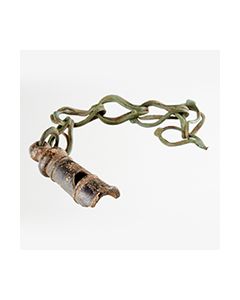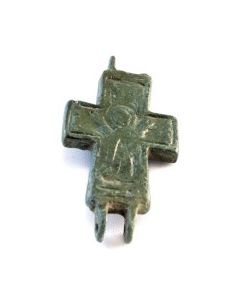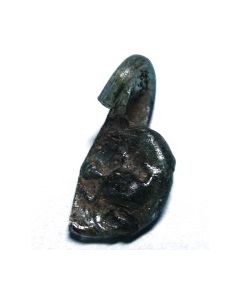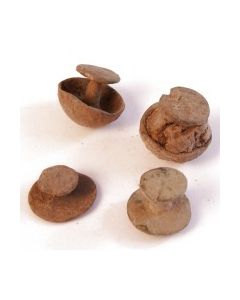Others - Southern Europe - Sold antiquities
Archive of sold antiquities
All artefacts sold in our gallery are fully documented in our online archive and database. Being a specialist ancient art dealer, preserving also the more recent history of each and every piece sold in our shop is at our heart. That is particularly useful for artefacts that changed owners in the meantime. Information that may have been lost in the process can be easily restored from our archives. Please do not hesitate to contact us if you need further information about ancient items that have been sold in our gallery. We can help you with reconstructing the history of ownership for those items. All information about our customers will be kept confidential, of course.-
 Ancient ladle with donkey head terminal
Ancient ladle with donkey head terminalElegant long bronze ladle, from the Greek or Etruscan culture. 5th to 4th century BC.
Price: on request Ancient ladle with bird head terminal
Ancient ladle with bird head terminalElegant long bronze ladle, from the Greek or Etruscan culture. 5th to 4th century BC.
Price: on request Base plate of a Roman mirror
Base plate of a Roman mirrorThe bronze disc is the base plate of a Roman mirror. A handle and reflective metal coating were once part of the mirror. Typical for upper class Roman households during Imperial times.
Price: on request Late Roman votive mirror
Late Roman votive mirrorExceedingly rare in this state of preservation, including remains of the original glass and reflective lead foil.
Price: on request Roman military whistle
Roman military whistleHistorically interesting example of Roman military equipment. Whistles of this type have been used in the 1st to 2nd cent. AD. Their function is not fully understood, yet.
Price: on request Whistle from plastic bronze
Whistle from plastic bronzeNice small whistle made of a high lead content bronze. Probably produced in the Modern Age.
Price: on request Roman military whistle
Roman military whistleHistorically interesting example of Roman military equipment. Whistles of this type have been used in the 1st to 2nd cent. AD. Their function is not fully understood, yet.
Price: on request Byzantinisches Bronzekreuz
Byzantinisches Bronzekreuz8. bis 10. Jh. n.Chr, Bronze. Teil eines Reliquienkreuzes mit stilisierter Mariendarstellung. Befestigungen weitgehend intakt. Länge: 48mm mit Ösen, 36mm nur Körper.
Price: on request Paar römischer Würfel
Paar römischer WürfelZwei römische Würfel aus Bein, etwa 3. bis 4. Jhd.n.Chr., aus röm. Provinz Pannonia. Vermutlich Eigentum von Soldaten.
Price: on request Paar römischer Würfel
Paar römischer WürfelZwei römische Würfel aus Bein, etwa 3. bis 4. Jhd.n.Chr., aus röm. Provinz Pannonia. Vermutlich Eigentum von Soldaten.
Price: on request Paar römischer Würfel
Paar römischer WürfelZwei römische Würfel aus Bein, etwa 3. bis 4. Jhd.n.Chr., aus röm. Provinz Pannonia. Vermutlich Eigentum von Soldaten.
Price: on request Römischer Würfel
Römischer WürfelEin römischer Würfel aus Bein, etwa 3. bis 4. Jhd.n.Chr., aus röm. Provinz Pannonia. Vermutlich Eigentum von Soldaten.
Price: on request Anhänger, Byzantinisch bis Osmanisch
Anhänger, Byzantinisch bis OsmanischSchön verzierter Anhänger, vermutlich byzantinische oder osmanische Zeit.
Price: on request Anhänger, Byzantinisch bis Osmanisch
Anhänger, Byzantinisch bis OsmanischSchön verzierter Anhänger, vermutlich byzantinische oder osmanische Zeit.
Price: on request Paar römischer Würfel
Paar römischer WürfelZwei römische Würfel aus Bein, etwa 3. bis 4. Jhd.n.Chr., aus röm. Provinz Pannonia. Vermutlich Eigentum von Soldaten.
Price: on request
 Byzantinisches Bronzekreuz
Byzantinisches Bronzekreuz8. bis 10. Jh. n.Chr, Bronze. Teil eines Reliquienkreuzes mit stilisierter Heiligendarstellung (Jesus). Höhe Kreuzkörper 34mm, Breite Kreuzkörper 24mm, Höhe mit Ösen 49mm.
Price: on request Fragment eines Anhängers mit Schildkrötendarstellung
Fragment eines Anhängers mit Schildkrötendarstellung1. Jh. v. Chr. bis 7. Jh. n. Chr., römisch bis byzantinisch. Hell-grünes, schön durchscheinendes Glas. Patiniert. Durchmesser 13mm, Länge22mm. 0,82g.
Price: on request Paar römischer Würfel
Paar römischer WürfelZwei römische Würfel aus Bein, etwa 3. bis 4. Jhd.n.Chr., aus röm. Provinz Pannonia. Vermutlich Eigentum von Soldaten.
Price: on request Paar römischer Würfel
Paar römischer WürfelZwei römische Würfel aus Bein, etwa 3. bis 4. Jhd.n.Chr., aus röm. Provinz Pannonia. Vermutlich Eigentum von Soldaten.
Price: on request Paar römischer Würfel
Paar römischer WürfelZwei römische Würfel aus Bein, etwa 3. bis 4. Jhd.n.Chr., aus röm. Provinz Pannonia. Vermutlich Eigentum von Soldaten.
Price: on request Paar römischer Würfel aus weißem Bein
Paar römischer Würfel aus weißem BeinPaar römischer Würfel aus weißem Bein, selten. Vermutlich Eigentum von Offizieren.
Price: on request Hellenistische Tontafel mit der Göttin Astarte
Hellenistische Tontafel mit der Göttin AstarteVotivtafel, 4. Jh. v.Chr., zeigt die Göttin stehend mit noch gut erkennbaren Konturen. 129mm hoch, ca. 62mm breit.
Price: on request Gruppe antiker Artefakte
Gruppe antiker ArtefakteGemischte Gruppe diverser kleiner Artefakten aus Metall. Zumeist Blei oder Bronze, Levante, Bronzezeit bis byzantinische Epoche.
Price: on request Bandelierbesetzung eines römischen Legionärs
Bandelierbesetzung eines römischen LegionärsBronzerosette, römische Militärdekoration. 3. Jh. n.Chr., gute Erhaltung. 27mm Durchmesser.
Price: on request Diverse römische Bronzeartefakte
Diverse römische BronzeartefakteFingerring und Teile römischer Militärausrüstung. 1. bis 4. Jh. n.Chr., römische Epoche. Germania Inferior.
Price: on request Vergoldete römische Gürtelschnalle
Vergoldete römische GürtelschnalleGürteldekoration oder -schnalle, vergoldete Bronze, 1. bis 3. Jh. n.Chr, pannonische Provinzen. In sehr schöner Erhaltung. 47mm x 21mm.
Price: on request Gruppe diverser römischer Befestigungen
Gruppe diverser römischer BefestigungenDiverse Befestigungen und Aufhängungen, vermutlich Teil römischer Militärausrüstung. Möglicherweise Zelthaken (oben). 1. bis 4. Jh. n.Chr., römische Epoche. Germania Inferior.
Price: on request Diverse römische Artefakte
Diverse römische ArtefakteNicht näher bestimmte Artefakte, vermutlich Zubehör für römische Militärausrüstung. 1. bis 4. Jh. n.Chr., römische Epoche. Germania Inferior.
Price: on request Diverse römische Artefakte
Diverse römische ArtefakteNicht näher bestimmte Artefakte, könnten Teil römischer Militärausrüstung sein. 1. bis 4. Jh. n.Chr., römische Epoche. Germania Inferior.
Price: on request Knöpfe von einer römischen Militärausrüstung
Knöpfe von einer römischen MilitärausrüstungDiverse Typen. 1. bis 4. Jh. n.Chr., römische Epoche. Germania Inferior.
Price: on request Zwei römische Artefakte
Zwei römische ArtefakteNicht näher bestimmte Artefakte, eines davon Pinnadel. 1. bis 4. Jh. n.Chr., römische Epoche. Germania Inferior.
Price: on request Massives römisches Bronzeobjekt
Massives römisches BronzeobjektVermutlich Verzierung einer militärischen Ausrüstung, römische Epoche, 1. bis 4. Jh. n.Chr., 55mm lang, 45mm Durchmesser. 242g. Germania Inferior.
Price: on request Knöpfe von einer römischen Militärausrüstung
Knöpfe von einer römischen MilitärausrüstungDiverse Typen. 1. bis 4. Jh. n.Chr., römische Epoche. Germania Inferior.
Price: on request Unbekanntes Objekt aus Gruppe römischer Artefakte
Unbekanntes Objekt aus Gruppe römischer ArtefakteMöglicherweise Teil eines Griffs. Vermutlich ebenfalls römische Epoche, 1. bis 4. Jh. n.Chr., 47mm lang, 23mm Durchmesser. Germania Inferior.
Price: on request Diverse römische Artefakte
Diverse römische ArtefakteNicht näher bestimmte Artefakte. 1. bis 4. Jh. n.Chr., römische Epoche. Germania Inferior.
Price: on request

